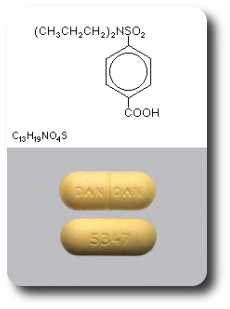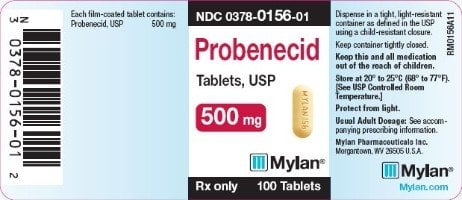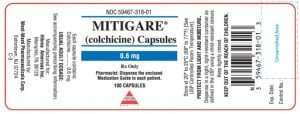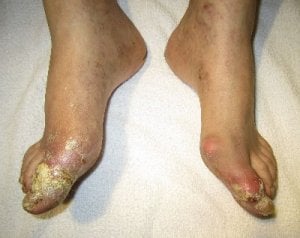Probenecid is a uricosuric and kidney blocking agent. It inhibits the re-absorption of uric acid in the kidneys, thus increasing the excretion of uric acid in urine and decreasing urate levels in the blood. This stops new crystals forming, and helps old crystal deposits to dissolve [1].
It is most useful to under-excreters of uric acid, and doctors will usually assess this by analyzing urine collected over a 24-hour period. It is also best to run kidney and liver function tests before and during probenecid therapy.
Probenecid

Besides gout, probenecid is also used to increase the effectiveness of penicillin, as it reduces the amount of penicillin excreted by the kidneys. It restricts excretion of other compounds that might cause problems. I will cover these in the benemid side effects page, but interestingly one additional effect can benefit gout sufferers.
Probenecid restricts a protein called pannexin which, one study reveals, can promote gouty inflammation [2]:
Thus it appears that probenecid may benefit gout patients in more than one way. In addition to the lowering of systemic uric acid by its action on tubular transport in the kidney, probenecid may stem inflammation through its inhibition of pannexin 1 channels.
Probenecid Contraindications
Probenecid should not be used by the following groups:
- Hypersensitivity to probenecid. This affects 2 to 4 percent of people [3]
- Not recommended for gout patients with known blood disorders or uric acid kidney stones.
- Small or large dose salicylates (aspirin). Acetaminophen (Tylenol), aka paracetamol (Panadol), is an acceptable alternative for mild pain relief.
- Not applicable to most gout sufferers, but children under 2 are excluded, and pregnant women need to carefully assess risks and benefits with their medical team.
It used to be recommended that probenecid should not be started during a gout attack. Now, research on other uric acid lowering dosing has shown that it is better to start dosing immediately. However, you will probably need colchicine and other pain relief for the first few months.
Probenecid Warnings
As with all uric acid lowering treatment, the gout medication can cause acute gout flares as old uric acid crystals start to dissolve. In such cases colchicine or other anti-inflammatory gout cure is advisable.
Probenecid affects concentrations of other medications, and dosage of certain co-prescribed drugs might need to be changed, including:
- Methotrexate
- Penicillin or other beta-lactams
- Pyrazinamide
- Sulfonamides, sulfonylureas, sulindac, sulfone
- Thiopental, ketamine
- Indomethacin, acetaminophen, naproxen, ketoprofen, meclofenamate, lorazepam, and rifampin
- Theophylline
Rarely, probenecid causes severe allergic reactions. Mostly, these happen within several hours after re-administration following prior usage of the drug. If hypersensitivity occurs, you must stop probenecid immediately, and discuss alternative uric acid lowering treatment with your doctor.

Probenecid Dosage And Administration
Probenecid should not be started during an acute gout attack. However, if a gout attack starts during treatment, probenecid should be continued at the same dose, and colchicine, or other anti-inflammatory treatment, should be given to control the pain.
The recommended dose for gout starts with 250 mg (half probenecid tablet), twice a day for one week. This will show if you are allergic to probenecid. After one week, assuming no rash or other symptoms of allergy, increase dosage to 500 mg (1 tablet) twice a day.
You need to return to the doctor each month (or as advised) during early stages of the treatment, as the daily 1000mg dosage may be insufficient. Your blood uric acid levels should be lower than 6mg/dL (0.36mmol/L). Your doctor may also advise retaking the 24-hour urine analysis to check that uric acid excretion has risen to 700mg or above. Dosage should be increased by 500 mg increments every 4 weeks within tolerance (and usually not above 2000 mg per day)
Probenecid may not be effective if you have chronic kidney disease with a glomerular filtration rate of 30 mL/minute or less.
Stomach problems may indicate your dose is too high, and you should discuss decreasing the dosage with your doctor.
Uric acid crystals may form if your urine is acid. You should drink plenty of water. My diet pages contain advice about maintaining alkaline urine, or you can take sodium bicarbonate (3 to 7.5 g daily), or potassium citrate (7.5 g daily). (also see Precautions in the Probenecid Side Effects Page). The risk of uric acid crystals reduces as you get rid of deposits in your joints and other parts of your body. Your urine test results should show uric acid in your urine returning to normal levels, at which point, you can relax the alkalizing regime.
Your blood test results should show uric acid below 6 mg/dL (0.36 mmol/L). When you have maintained that level without gout flares for 6 months, you can assume all old crystals have dissolved, and then continue with a maintenance dose. In conjunction with regular blood tests, you may reduce the dose by 500 mg every 6 months, but never allow uric acid in the blood to rise much above 6 mg/dL (0.36 mmol/L), with an absolute maximum of 6.5 mg/dL (0.39 mmol/L).
Probenecid Spellings
Like many medicines, probenecid is often misspelled. Though spelling is often overrated, it pays to take extra care with medicines, as a misunderstanding might cause treatment problems in the unlikely event of a similar sounding drug being taken mistakenly.
In the list below, I have included brand names, where the active ingredient is probenecid alone (it is frequently mixed with colchicine). When buying medicine, it is usually best to use the generic name rather than a brand name, unless additional active ingredients make the gout medicine more useful to you.
- Probenacid
-
Second e changed to a.
- Probencid
-
Missing second e.
- Probenecid
-
This is the correct spelling of the uricosuric drug probenecid, which encourages uric acid excretion in those gout patients who are under-excreters.
- Probenecid Brands
-
Common brand names include: Benemid; Probecid; Benecid; Benuryl; Pro-Cid
- Probenesid
-
ecid changed to esid.
- Probenicid
-
Second e changed to i.
- Probinicid
-
ene changed to ini.
If you are aware of other alternative spellings or common brand names, please share them on the gout remedies forum.
Leave to browse more Gout Medications To Lower Uric Acid.
Probenecid Related Topics
Please remember: to find more related pages that are relevant to you, use the search box near the top of every page.
Common Terms: info, medication, probenecid, side effects, spell
Other posts that include these terms:
- Purine Rich Foods
- Gout and Alcohol: Tequila and Gout
- How to Avoid Gout Medication Side Effects
- Uloric (febuxostat) Guidelines
- Gout Info Update Service – Stay Updated about Gout
- 40 30 30 Zone Diet for Lower Uric Acid
- Starting Allopurinol – Dosing Guidelines
- What Is Allopurinol?
- Colcrys (Colchicine)
- Indomethacin: Gout Facts
Probenecid References
- Much of the information in this article is derived from probenecid prescribing labels, in particular, Lannett Company Inc, Philadelphia PA.
- Probenecid, a gout remedy, inhibits pannexin 1 channels. Silverman W, Locovei S, Dahl G. Am J Physiol Cell Physiol. 2008 Sep;295(3):C761-7.
- Sheila Hutman. Aids Patient Care. October 1991, 5(5): 242-243. doi:10.1089/apc.1991.5.242
Please give your feedback
Did this page help you? If yes, please consider a small donation. Your donations help keep GoutPal's gout support services free for everyone.
If not, please tell me how I can improve it to help you more.
- YouTube
- The gout forums.








